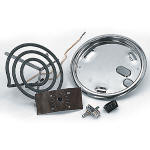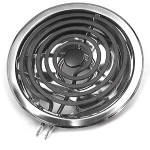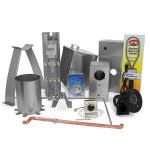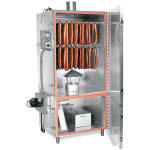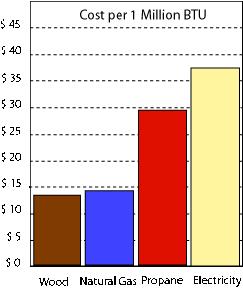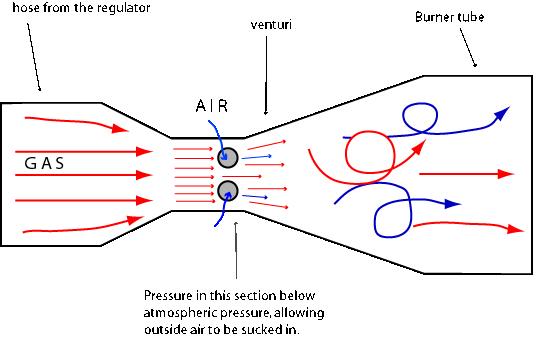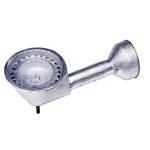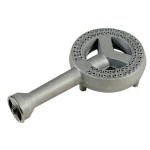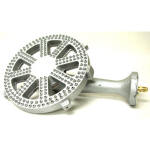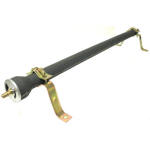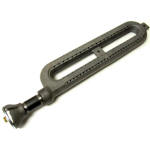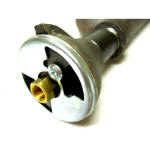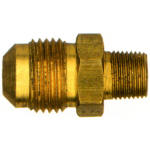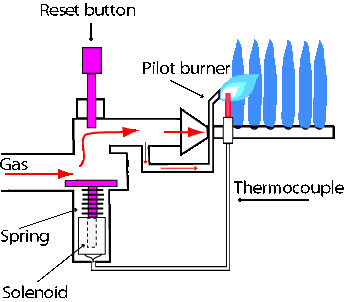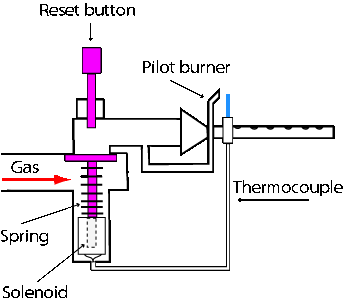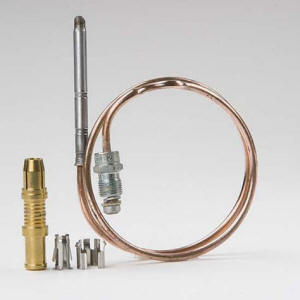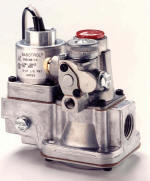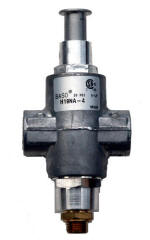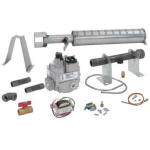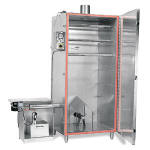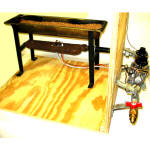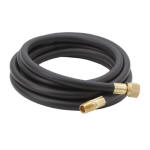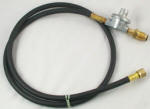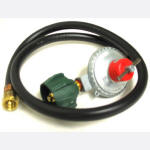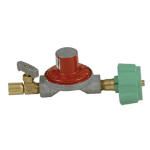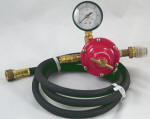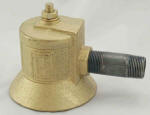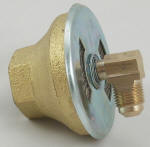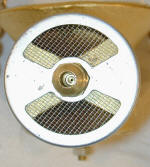Meats and Sausages
Smokehouse Burners
Smokehouse heating systems depend on the type of fuel chosen. If heating is to be efficient and easy to control, the smokehouse must be well insulated, which becomes especially important in cold weather.
There are three types of fuel used in smokers
- Wood - commonly used in home made smokers situated outside.
- Electricity - factory made smokers. Wood chips or sawdust are still needed for smoke generation.
- Gas - natural or propane. Preferred fuel in large industrial smokers. Wood chips or sawdust are still needed for smoke generation.
Wood is the traditionally used fuel in outside smokehouses because:
- It is easy to obtain
- It is free
- It is dependable
- It is fun - when burning wood in a simple home made smoker, it looks prettier than any factory made mode
Wood presents very few safety problems. There is a remote chance of a fire and no chance of explosion which may occur in a gas fired systems. To control and maintain the temperature when burning wood is difficult, especially when using a smaller smokehouse. Here, the fire pit design will be a key to the success and great location with air controlling dampers will play a crucial role. The fire pit design is covered in details in the section on fire pits. Some smokers use charcoal as fuel though wood chips or sawdust is still needed to produce smoke. Charcoal briquettes may be an acceptable fuel for a barbecue but don’t belong in a real smoking category as they often leave an unpleasant undertaste in smoked products. If as the last resort you have to use them, make sure they burn outside of a smoker first until thoroughly covered with white ash before entering the smoking chamber.
The wood fired traditional smoker is a beautiful design capable of producing the highest quality product, but a smoker can become more user friendly by using additional types of fuel, like electricity or gas. Smoke will still be generated by burning wood chips in a preferably free standing smoke generator (fire pit), but the smoking chamber, which now becomes a cooking chamber, will benefit greatly with the addition of a controlable heating element or a gas burner.
This will give us the following advantages:
- Heat on demand - just with the turn of a dial
- Very accurate temperature control - a thermostat can be added to a heating element and we can go and watch TV
- Total portability of a propane gas tank and burner
- Ability to easily use propane fuel - a great aid for those smoking outside city limits without electricity
- Consistent physical size and dimension of the smoker, all that is needed is installing a heating element or gas burner inside of a fire box.
- On demand source of additional heat - a smoker can fully operate in its wood burning mode and the electric or gas option could be applied in very cold weather.
Electricity, depending on location, can be inexpensive (Florida) or very costly (New York) and can be a cost factor when smoking a product for two days or longer. Its advantages are that it is easy to use and allows for a precise temperature control especially when the smoker has a thermostat. An extension cable can provide electricity to the outside located smokehouse but a permanent electrical connection will be more elegant. A conduit pipe can be run underground to the point where a junction box could be installed. Small 500 W or 1000 W heating elements will use 115 volts but anything bigger than 2000 W will need 220 volts. Electrical heating is a popular method for smokers of smaller size.
Photos courtesy Sausagemaker, Buffalo, New York.
With electricity there are are no safety concerns. In the worst case we may blow a fuse which is not a great deal.
From a technical point of view installing electrical burners is much easier than putting together a gas system as we dont't have to deal with safety issues like flame blow out. There is no need for thermocouples and safety valves and the installation costs are much lower. Much less of a technical know-how is needed to put a system together. If a smokehouse is the size of a refrigerator you will need a stronger electrical burner (5000 W). Another burner can be easily added, too. Besides burners, many other devices (thermostat, control lamps, outside lamps, blower, smoke generator etc.) need 115 volts and you will probably end up needing 115 v and 230 v AC.
Many factory made smokehouses can be ordered to run on either electricity or gas.
Gas is the cheapest energy and that is why it is used in commercial smokers and other kitchen equipment. Gas burners are easy to control and are able to supply huge amounts of heat. On a downside they present a few safety problems. There are basically two types of gas:
Natural gas - no color or smell, consisting mainly of methane (80 – 95%) and other gases like carbon dioxide, carbon monoxide, nitrogen, helium and argon. Its characteristic and unpleasant odor is achieved by purposely adding chemicals that create that smell. The natural gas pressure is very low and it varies from 6 to 10 of WC (water column). This is less than 1 PSI.
To use natural gas a gas pipe, commonly ½” diameter, has to be brought into the smoker and terminated with a valve. On the other side of the valve there will be a fitting and supply line to the burner. Large metropolitan areas are normally piped for natural gas but in some states, for example Florida, the natural gas is not available in most parts of the state. The disadvantage of a natural gas connection is that it requires metal pipe lines which once in place, can not be moved with a smokehouse to a new location. The amount of gas that can be delivered to the smokehouse depends on the pressure in the local system, length of pipe run, pipe size, the number of turns and the meter capacity. The disadvantge of a gas installation is its very permanent installation, metal pipe lines and more technical expertise needed for making connections. Its main plus is that you never run out of gas.
Propane – made by distilling a natural gas. Propane is heavier than a natural gas or air and it is stored in tanks as a liquid, under pressure. At 0° F the tank pressure is 24 PSI, at 30° F the pressure is at 51 PSI, at 70° F the pressure is 100 PSI, at 90° F it is 150 PSI and at 130° it is 260 PSI. When a propane tank reaches 120° F, the pressure inside is trippled and the tank may release some of the excess pressure through the safety relief valve. There are many camping units with one or two burners and different size propane bottles available at all major department stores. A typical grill's 20-pound cylinder holds five gallons of propane. The propane is filled in the bottle as a liquid, and the new valves have a float that rises as the bottle is filled to lock off the opening once the tank has reached 80 percent full.
Almost all outdoor cooking equipment runs on propane gas and we are going to cover propane burners in more detail. The propane tanks and related hardware are available everywhere and the installation of a customised system neither require heavy technical skills nor professional tools.
| Comparing the Cost of Heating Fuels - September 2005 | ||||
|---|---|---|---|---|
| Type of Energy | BTU/unit | Adjusted Effciency | $/unit | $/Million BTU |
| Wood, cord (green), 4'x8'x4' | 22,000,000 | 60% | $170.00 | $12.88 |
| Electricity, kwh | 3,412 | 100% | $0.13 | $37.51 |
| Natural Gas, therm | 100,000 | 80% | $1.19 | $14.88 |
| Propane, gallon | 91,600 | 80% | $2.15 | $29.33 |
The above data courtesy of The Vermont Department of Public Service.
The efficiency of the freshly cut wood is 60% (see the table). If this wood were seasoned (dry) its efficiency would be about 80%.
What is British Thermal Unit (BTU), MBTU, MMBTU ?
A standard unit of measurement used to denote both the amount of heat energy in fuels and the ability of appliances and air conditioning systems to produce heating or cooling. A BTU is the amount of heat required to increase the temperature of a pint of water (which weighs exactly 16 ounces) by one degree Fahrenheit. Since BTUs are measurements of energy consumption, they can be converted directly to kilowatt-hours (3412 BTUs = 1 kWh) or joules (1 BTU = 1,055.06 joules). A wooden kitchen match produces approximately 1 BTU, and air conditioners for household use typically produce between 5,000 and 15,000 BTU.
MBTU stands for one million BTUs, which can also be expressed as one decatherm (10 therms). MBTU is occasionally used as a standard unit of measurement for natural gas and provides a convenient basis for comparing the energy content of various grades of natural gas and other fuels. One cubic foot of natural gas produces approximately 1,000 BTUs, so 1,000 cu. ft. of gas is comparable to 1 MBTU. MBTU is occasionally expressed as MMBTU, which is intended to represent a thousand thousand BTUs.
Note An average home consumes between 25 and 100 million BTU per year.
Gas Burners
Both natural gas and propane burners work on the same principle called the "venturi effect". It says that as a gas or fluid passes through a pipe that narrows or widens, the velocity and pressure of the gas or fluid vary. As the pipe narrows, the gas flows more rapidly. What sounds like a surprise but holds true, is that when the fluid or gas flows faster through the narrow sections, the pressure actually decreases rather than increases. The venturi tube is a large diameter tube, gradually feeding into a smaller tube and then gradually becoming a larger tube.
The photos below show examples of different burners, all operating on a venturi principle. One of the main advantages of Venturi systems is operation without electricity.
Photos of the burners courtesy Allied Kenco Sales, Houston, Texas.
The most important part of the burner is the orifice plug with the hole in it. This is the point where the gas escapes from the hose or a pipe and enters the mixing bell of the burner. Orifice plugs are replaceable and screwed into the orifice spud. Nearly all atmospheric (venturi) burners have a gas orifice that is accurately fixed in the burner throat providing air intake. The hole in the orifice is very small to provide the correct gas flow and to provide sufficient velocity to ensure there is a suction (vacuum) available for the correct air inspiration.
There are orifice charts that specify what diameter orifice hole should be drilled for a particular burner. Those holes are normally very small, about 1/16" (1.5 mm) or less. They may be bigger when burning natural gas. An example of how a 1 mm orifice hole used at different gas pressures affects the amount of generated heat is presented below:
| Low Pressure Chart | High Pressure Chart-Liquid Propane | |||||||||
|---|---|---|---|---|---|---|---|---|---|---|
| BTU/hr | BTU/hr | |||||||||
| Drill Size | Decimal | Metric | Natural Gas | Natural Gas | Liquid Propane | 5 PSI | 10 PSI | 15 PSI | 20 PSI | 25 PSI |
| 60 | 0.040 | 1 mm | 4" WC (Water Column) | 7" WC | 11" WC | |||||
| 4350 BTU/hr | 5750 | 11175 | 39689 | 56130 | 68745 | 79380 | 88750 | |||
It can be seen from the table that at 25 PSI, a propane burner will supply 20 times more heat than a natural gas burner at 4" WC.
| Pressure Conversion Chart | |
|---|---|
| Inches of water (WC-water column) | Pounds per square inch (PSI) |
| 4 | 0.1445 |
| 7 | 0.2529 |
| 11 | 0.3974 |
The pressure of natural gas in a pipe is very low and its venturi is able to suck in only about 40% of the needed air into the burner. The burning flame consumes the rest of the needed air from the air that surrounds it. This is the reason why all-natural gas appliances have such generous air openings near the burners. This also means that the gas burner may not work too well when placed inside the smoking chamber when heavy smoke keeps pouring into it. Because of the natural gas low pressure there is no need for a regulator.
Propane gas is flowing out of a regulator at a much higher pressure and is able to suck in all needed air into the burner, providing that the venturi chamber is located outside of the smokehouse. Propane gas leaving the tank goes to the regulator first, which may be either fully adjustable (0-20 or 0-30 psi) or preset type (10 or 20 psi). The adjustable regulators usually have a large knob for adjustments. All regulators do basically one function: they reduce a higher pressure down to a lower pressure and keep it constant (regulated). There are also propane gas regulators that are preset to 6 ounces of pressure and they are considered low pressure regulators. Although they are preset they may have a small range of adjustment. Needless to say, they will supply less heat than a high-pressure burner.

A typical propane system
Note There are very strong power burners where venturi is not needed. The gas burner and the air supply are two independent systems where air is supplied by the electrical blower. These powerful burners are capable of melting glass or metals and have no practical use in a smokehouse.
Smokehouse burners
If the smokehouse is small, you are better off installing an electrical heating element. It will be faster, easier and cheaper. Choosing a gas burner for a large smokehouse presents a little problem. Let's say that the inside of your smokehouse is 36 wide, 2' deep, and 6' high, a total of 36 cubic feet. Most gas burners are very short, 4 - 6" and if placed inside, will provide heat by the side wall only. Since the Venturi part and the connecting hose should be outside of the unit, you are left with a burner head situated a few inches from the wall. There will be uneven heat distribution in a smokehouse chamber as the heat will go straight up where the burner is placed. You could, of course, use a blower, but that complicates the design that we try to keep very simple. What you will need is a long burner like the 32" long burner in the photo in the table above. If the entire burner must be placed inside, replace the hose with an iron pipe. Keep in mind that now, when the venturi is inside it needs sufficient air supply. The air may come in the smoke delivery pipe or some opening must be provided.
Using this adjustable length burner, it is possible to place the burner in the center of any size smokehouse. Using a simple T connection it is practical to connect a second burner. For more even heat distribution a metal plate (baffle) can be placed above the burner.
Burner Safety Issues
As of this writing (2006), in the USA most burners used in outdoor cooking equipment don't require safety valves. In Europe and in Asia, the government guidelines are stricter and the safety valve must be installed. The American school of reasoning believes that in outdoor cooking equipment (propane) when the flame goes out, the gas can safely escape to the atmosphere and the cook will eventually discover the fact. A smokehouse, like many other gas-heated appliances (ovens, water heaters), presents safety hazards. All the above appliances make use of a pilot light to ignite the main gas burners. If the flame of the burner or the pilot light becomes extinguished for any reason, the gas will keep on going into the smokehouse, creating both a risk of fire and a health hazard. The risk will deepen even further if the smoke generator is supplying smoke at the same time as this may deliver a spark to ignite the gas. This is another reason why a smokehouse should have sufficient air draft. The draft will allow gas to burn cleanly and push the exhaust gases out.
To eliminate this danger, a device called a thermocouple is used to sense when the pilot light is burning. A thermocouple consists of two dissimilar metals that are joined together at the sensing end. A different voltage is generated, typically between 1 to about 70 microvolts per degree Celsius which increases with temperature. The tip of a thermocouple is placed in the flame, and as long as the thermocouple remains hot it holds the pilot gas valve open. If the pilot light goes out, the temperature of the thermocouple drops and the gas supply valve will close, shutting off the gas to the pilot light. The same thermocouple controls the main gas valve in the same manner. The thermocouple voltage, typically around 20 mV, operates the gas supply valve responsible for feeding the pilot.
Safety valve
These valves house the thermomagnet that provides gas shut down if the safety thermocouple is not heated. There is a connection for a thermocouple, a gas supply to a pilot burner and the manual reset.
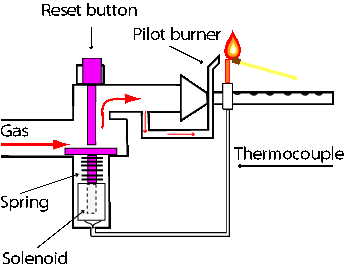
To start the burner again we have to open the flow of gas. The thermocouple is cold and the voltage is too low for the solenoid to pull the valve down. The manual reset button has to be pushed down to open the gas supply so the pilot can be re-lit. The reset button has to be held down for 20 more seconds to warm up the thermocouple. Now when the thermocouple is hot again, it produces enough voltage for the solenoid to hold down the valve.
Although it is feasible to design and install our own gas heating system, nevertheless the fastest approach will be to order a gas kit with assembly instructions.
Hoses, Gauges and Regulators
The gas from the tank flows to the regulator and then through the safety valve (if used) into the burner. In most cases the hose comes with a regulator already attached to it. There are two types of regulators:
- Pre-set pressure type - the pressure is fixed in the factory and the small dial allows for some finer tuning
- Variable pressure regulator - the regulator has a much bigger knob and allows for adjusting the pressure in a much wider range, for example from 0 - 35 PSI or from 0 - 20 PSI.
Photos courtesy Tejas Smokers, Texas
Using an adjustable pressure regulator, we can not determine what is the exact gas pressure flowing into the burner. A pressure gauge is needed to display the actual pressure reading. This way we can have the same gas pressure every time we use the system.
There is a very clever burner design from Tejas Smokers, Texas. They have physically separated the burner head from the venturi by a common, adjustable-length steel pipe.
Above photos courtesy Tejas Smokers, Texas
A point should be stressed here, that all smokehouse gas burners are subject to burner safety issues explained earlier on this page. Natural gas or propane must go first to the safety valve, and only from there it can flow into the burner.
Disclaimer
The information provided in this chapter on making your own burners and installing your own gas heating systems is for educational purposes only. Gas systems of any kind are very dangerous, and the actual work involved in making or assembling any components or the whole system should be performed by a qualified and licensed plumber or contractor only.

